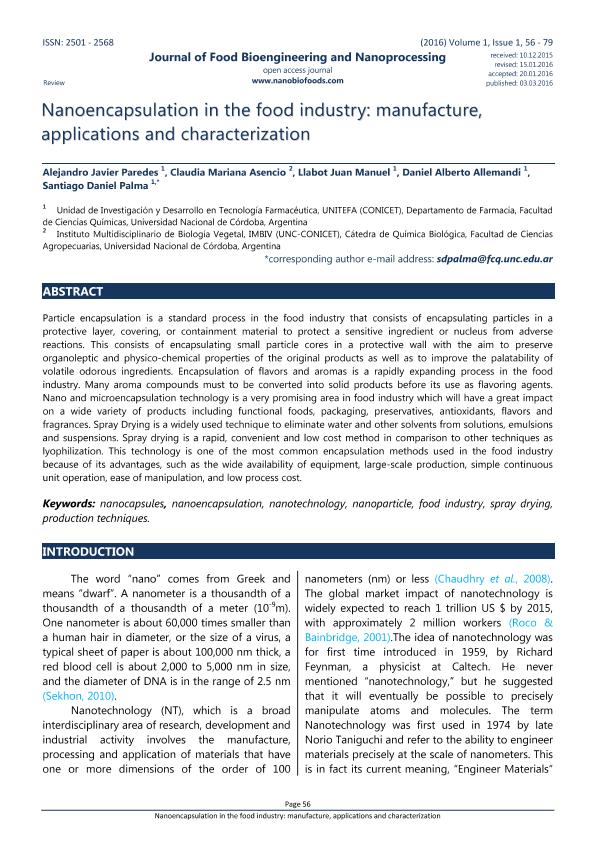Artículo
Nanoencapsulation in the food industry: manufacture, applications and characterization
Paredes, Alejandro Javier ; Asensio, Claudia Mariana
; Asensio, Claudia Mariana ; Llabot, Juan Manuel
; Llabot, Juan Manuel ; Allemandi, Daniel Alberto
; Allemandi, Daniel Alberto ; Palma, Santiago Daniel
; Palma, Santiago Daniel
 ; Asensio, Claudia Mariana
; Asensio, Claudia Mariana ; Llabot, Juan Manuel
; Llabot, Juan Manuel ; Allemandi, Daniel Alberto
; Allemandi, Daniel Alberto ; Palma, Santiago Daniel
; Palma, Santiago Daniel
Fecha de publicación:
03/03/2016
Editorial:
Nanobiofoods
Revista:
Journal of Food Bioengineering and Nanoprocessing
ISSN:
2501-2568
e-ISSN:
2501-2568
Idioma:
Inglés
Tipo de recurso:
Artículo publicado
Clasificación temática:
Resumen
Particle encapsulation is a standard process in the food industry that consists of encapsulating particles in a protective layer, covering, or containment material to protect a sensitive ingredient or nucleus from adversereactions. This consists of encapsulating small particle cores in a protective wall with the aim to preserveorganoleptic and physico-chemical properties of the original products as well as to improve the palatability ofvolatile odorous ingredients. Encapsulation of flavors and aromas is a rapidly expanding process in the foodindustry. Many aroma compounds must to be converted into solid products before its use as flavoring agents.Nano and microencapsulation technology is a very promising area in food industry which will have a great impacton a wide variety of products including functional foods, packaging, preservatives, antioxidants, flavors andfragrances. Spray Drying is a widely used technique to eliminate water and other solvents from solutions, emulsionsand suspensions. Spray drying is a rapid, convenient and low cost method in comparison to other techniques aslyophilization. This technology is one of the most common encapsulation methods used in the food industrybecause of its advantages, such as the wide availability of equipment, large-scale production, simple continuousunit operation, ease of manipulation, and low process cost.
Archivos asociados
Licencia
Identificadores
Colecciones
Articulos(CCT - CORDOBA)
Articulos de CTRO.CIENTIFICO TECNOL.CONICET - CORDOBA
Articulos de CTRO.CIENTIFICO TECNOL.CONICET - CORDOBA
Articulos(UNITEFA)
Articulos de UNIDAD DE INVESTIGACION Y DESARROLLO EN TECNOLOGIA FARMACEUTICA
Articulos de UNIDAD DE INVESTIGACION Y DESARROLLO EN TECNOLOGIA FARMACEUTICA
Citación
Paredes, Alejandro Javier; Asensio, Claudia Mariana; Llabot, Juan Manuel; Allemandi, Daniel Alberto; Palma, Santiago Daniel; Nanoencapsulation in the food industry: manufacture, applications and characterization; Nanobiofoods; Journal of Food Bioengineering and Nanoprocessing; 1; 1; 3-3-2016; 56-79
Compartir



